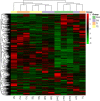Comparative transcriptome combined with metabolome analyses revealed key factors involved in nitric oxide (NO)-regulated cadmium stress adaptation in tall fescue
- PMID: 32867669
- PMCID: PMC7457814
- DOI: 10.1186/s12864-020-07017-8
Comparative transcriptome combined with metabolome analyses revealed key factors involved in nitric oxide (NO)-regulated cadmium stress adaptation in tall fescue
Abstract
Background: It has been reported that nitric oxide (NO) could ameliorate cadmium (Cd) toxicity in tall fescue; however, the underlying mechanisms of NO mediated Cd detoxification are largely unknown. In this study, we investigated the possible molecular mechanisms of Cd detoxification process by comparative transcriptomic and metabolomic approaches.
Results: The application of Sodium nitroprusside (SNP) as NO donor decreased the Cd content of tall fescue by 11% under Cd stress (T1 treatment), but the Cd content was increased by 24% when treated with Carboxy-PTIO (c-PTIO) together with Nitro-L-arginine methyl ester (L-NAME) (T2 treatment). RNA-seq analysis revealed that 904 (414 up- and 490 down-regulated) and 118 (74 up- and 44 down-regulated) DEGs were identified in the T1 vs Cd (only Cd treatment) and T2 vs Cd comparisons, respectively. Moreover, metabolite profile analysis showed that 99 (65 up- and 34-down- regulated) and 131 (45 up- and 86 down-regulated) metabolites were altered in the T1 vs Cd and T2 vs Cd comparisons, respectively. The integrated analyses of transcriptomic and metabolic data showed that 81 DEGs and 15 differentially expressed metabolites were involved in 20 NO-induced pathways. The dominant pathways were antioxidant activities such as glutathione metabolism, arginine and proline metabolism, secondary metabolites such as flavone and flavonol biosynthesis and phenylpropanoid biosynthesis, ABC transporters, and nitrogen metabolism.
Conclusions: In general, the results revealed that there are three major mechanisms involved in NO-mediated Cd detoxification in tall fescue, including (a) antioxidant capacity enhancement; (b) accumulation of secondary metabolites related to cadmium chelation and sequestration; and (c) regulation of cadmium ion transportation, such as ABC transporter activation. In conclusion, this study provides new insights into the NO-mediated cadmium stress response.
Keywords: Cd stress; Detoxification mechanism; Metabolite profiling; Nitric oxide; RNA-Seq; Tall fescue.
Conflict of interest statement
The authors declare that they have no competing interests.
Figures







Similar articles
-
Metabolome and transcriptome association analysis revealed key factors involved in melatonin mediated cadmium-stress tolerance in cotton.Front Plant Sci. 2022 Sep 20;13:995205. doi: 10.3389/fpls.2022.995205. eCollection 2022. Front Plant Sci. 2022. PMID: 36204073 Free PMC article.
-
Transcriptome analysis providing novel insights for Cd-resistant tall fescue responses to Cd stress.Ecotoxicol Environ Saf. 2018 Sep 30;160:349-356. doi: 10.1016/j.ecoenv.2018.05.066. Epub 2018 May 31. Ecotoxicol Environ Saf. 2018. PMID: 29860131
-
Nitric oxide alleviates toxicity of hexavalent chromium on tall fescue and improves performance of photosystem II.Ecotoxicol Environ Saf. 2018 Nov 30;164:32-40. doi: 10.1016/j.ecoenv.2018.07.118. Epub 2018 Aug 7. Ecotoxicol Environ Saf. 2018. PMID: 30096601
-
Transcriptomic and metabolomic insights into the antimony stress response of tall fescue (Festuca arundinacea).Sci Total Environ. 2024 Jul 10;933:172990. doi: 10.1016/j.scitotenv.2024.172990. Epub 2024 May 6. Sci Total Environ. 2024. PMID: 38710395
-
High temperature damage to fatty acids and carbohydrate metabolism in tall fescue by coupling deep transcriptome and metabolome analysis.Ecotoxicol Environ Saf. 2020 Oct 15;203:110943. doi: 10.1016/j.ecoenv.2020.110943. Epub 2020 Jul 13. Ecotoxicol Environ Saf. 2020. PMID: 32678750
Cited by
-
Integration of transcriptome and metabolome analyses reveals sorghum roots responding to cadmium stress through regulation of the flavonoid biosynthesis pathway.Front Plant Sci. 2023 Feb 23;14:1144265. doi: 10.3389/fpls.2023.1144265. eCollection 2023. Front Plant Sci. 2023. PMID: 36909379 Free PMC article.
-
Quantitative Succinyl-Proteome Profiling of Turnip (Brassica rapa var. rapa) in Response to Cadmium Stress.Cells. 2022 Jun 17;11(12):1947. doi: 10.3390/cells11121947. Cells. 2022. PMID: 35741076 Free PMC article.
-
Integrated Analysis of Metabolome and Transcriptome Reveals Insights for Cold Tolerance in Rapeseed (Brassica napus L.).Front Plant Sci. 2021 Oct 8;12:721681. doi: 10.3389/fpls.2021.721681. eCollection 2021. Front Plant Sci. 2021. PMID: 34691103 Free PMC article.
-
Reactive oxygen species- and nitric oxide-dependent regulation of ion and metal homeostasis in plants.J Exp Bot. 2023 Oct 13;74(19):5970-5988. doi: 10.1093/jxb/erad349. J Exp Bot. 2023. PMID: 37668424 Free PMC article.
-
Morphological and molecular response mechanisms of the root system of different Hemarthria compressa species to submergence stress.Front Plant Sci. 2024 Apr 4;15:1342814. doi: 10.3389/fpls.2024.1342814. eCollection 2024. Front Plant Sci. 2024. PMID: 38638357 Free PMC article.
References
-
- Wang D, Liu Y, Tan X, et al. Effect of exogenous nitric oxide on antioxidative system and S-nitrosylation in leaves of Boehmeria nivea (L.) Gaud under cadmium stress. Environ Sci Pollut R. 2015;22(5):3489–3497. - PubMed
-
- Huang CL, Bao LJ, Luo P, et al. Potential health risk for residents around a typical e-waste recycling zone via inhalation of size-fractionated particle-bound heavy metals. J Hazard Mater. 2016;317:449–456. - PubMed
MeSH terms
Substances
Grants and funding
LinkOut - more resources
Full Text Sources

